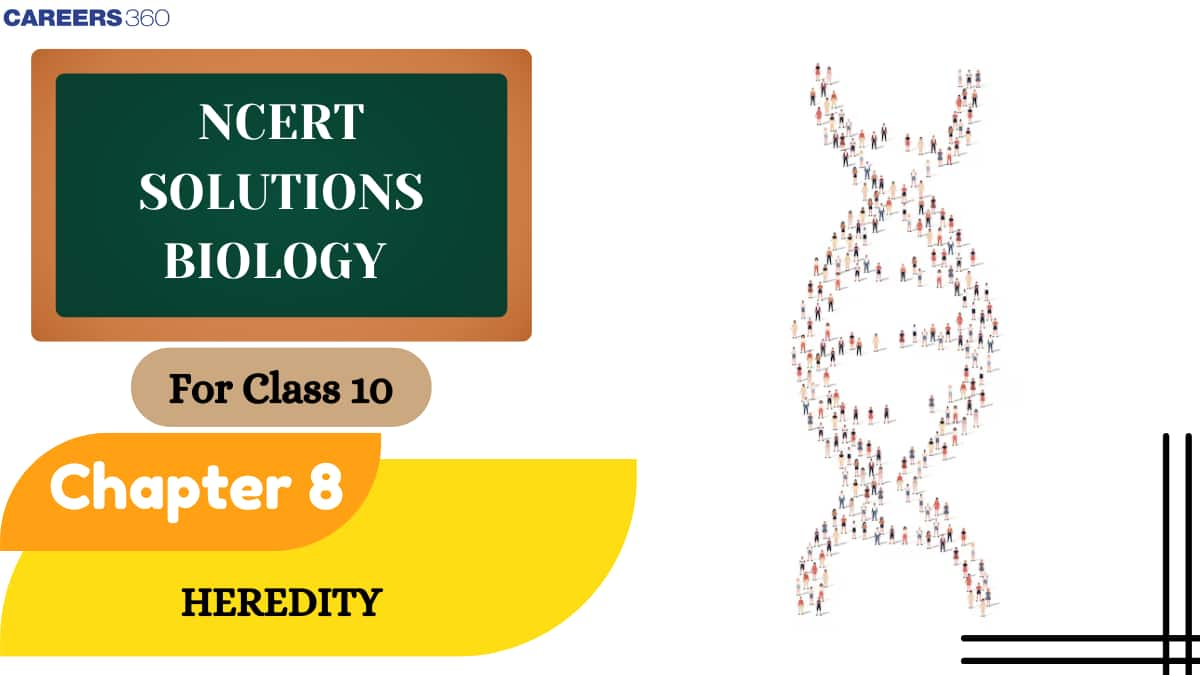This chapter helps students understand the basic principles of inheritance and how genetic variation occurs in living organisms.
Aakash Repeater Courses
Take Aakash iACST and get instant scholarship on coaching programs.
NCERT Solutions for Class 10 Science Chapter 8 Heredity describes how characteristics and traits are inherited by a child from their parents. It discusses important topics such as Mendel's laws of inheritance, dominant and recessive characteristics, sex determination, and variation in genes. By reading the answers of this chapter, students get to know about the genetic characteristics we inherit, like the colour of our eyes and hair type. The NCERT Solutions provide clear and detailed answers to questions, making it easier for students to understand and learn each topic.

The NCERT Solutions for Class 10 use diagrams and illustrations to describe complex concepts simply. The Heredity chapter explains how both heredity and the environment affect the development and growth of living organisms. These are important for the study of genetics and evolution. To perform well in examinations, students must study through the NCERT Solutions for Class 10 Science and finish the syllabus thoroughly in advance, so that they can focus on revision and improve their problem-solving speed.
Also Read,
Get easy access to solutions that cover all important concepts from the Heredity chapter, which is available in a free downloadable PDF format below.
In this section, students will see the NCERT Questions. These questions are one of the most important parts of understanding the topics. Students must go through these questions and answer them to make their base stronger.
Answer:
Trait B is more likely to have arisen earlier because it has a higher percentage of the population and in asexual reproduction, traits are carried over to the next generation with minimal changes in the traits.
For example, all the sugarcane in the field that reproduces asexually, have almost similar characteristics, however, the animals and humans which reproduce sexually, have more variation of traits in the next generation.
Q. 2. How does the creation of variations in a species promote survival?
Answer:
Variation in our characteristics occurs due to sexual reproduction and inaccurate copying of DNA. The varied characteristics that fit for survival pass on to the next generation more easily and the characteristics that are not favourable for survival will vanish after some generation.
Favourable variations help a species to adapt to changes in its environment and they promote the survival of a species.
Exercise 8.2
Q. 1. How do Mendel’s experiments show that traits may be dominant or recessive?
Answer:
Mendel conducted many experiments by crossing the Tall plants and Short plants. He found that the trait Tall which appears in the first generation, also appeared in the second generation, with 75 % in number. and the trait short appeared in the second generation by 25% in number. Hence he concluded that trait Tall is Dominant and the trait Short is recessive.
In other words:
Tall + Tall = Tall
Tall + Short = Tall
Short + Tall = Tall
Short + Short = Short
As we can see there are 3 out of 4 Tall in the Next Generation. Hence it is a dominant trait.
Hence by this experiment, he showed that traits can be Dominant or Recessive.
Q. 2. How do Mendel’s experiments show that traits are inherited independently?
Answer:
Mendel performed a dihybrid cross between pure-breeding tall plants with round seeds and short plants with wrinkled seeds. In the next generation, he observed not only the original combinations (tall-round and short-wrinkled) but also new combinations like tall-wrinkled and short-round were formed.
This result showed:
Tall and Round + Short and Wrinkled → Tall and Round + Tall and Wrinkled + Short and Round + Short and Wrinkled
The appearance of new trait combinations like tall-wrinkled and short-round proved that the inheritance of one trait (like plant height) does not depend on the inheritance of another trait (like seed shape).
Hence, he concluded that traits are inherited independently
Answer:
No, this information is not sufficient to conclude any trait is dominant or recessive. this is because we don't know the blood group of all offspring.
The given blood group A can be AA or AO, so we can't really draw any conclusion from it.
Q. 4. How is the sex of the child determined in human beings?
Answer:
Half the male gametes have X-chromosomes and the other half have Y-chromosomes human male has one X-chromosome and one Y-chromosome. In other words, the human male has one X chromosome and one Y chromosome On the other hand, all-female gametes have only X chromosomes. If a sperm carrying a Y-chromosome fertilises an ovum, then the child born will be a boy.
On the other hand, if a sperm carrying X-chromosomes fertilises an ovum, then the child born will be a girl.
X + X = Girl
X + Y = Boy.
Here are the step-by-step solutions to the Heredity chapter-end exercise questions, which help in revising the concepts thoroughly and easily
(a) TTWW
(b) TTww
(c) TtWW
(d) TtWw
Answer:
As half the progenies are short, this implies that the parent plant also will have a collection of short genes. Also since all progenies bore violet flowers, the violet colour is dominant over white.
Hence, TtWW might be the correct answer.
Answer:
To consider a trait as dominant or recessive, we need the information from a minimum of 3 generations.
If the grandparent, parent and the children. If all have light-coloured eyes, then we can conclude that light-eyed colour is a dominant trait.
Answer:
(i) Select two varieties of dogs, one with white coat colour, the other with black coat colour.
(ii) Crossbreed them taking a male dog from one variety and bitch (female dog) from the other variety.
(iii) Observe the colour of the offspring of the F1 generation.
(iv) Now, bring about breeding among the organisms of the F1 generation.
(v) Observe the coat colour of the organisms (pups) of the F2 generation and note the variations in coat colour.
(vi) Draw conclusions based on your study.
One of the probable inheritance patterns may be as given below.
Phenotypic ratio = 3: 1,
Black coat colour (3): White coat colour (1)
Q. 4. How is the equal genetic contribution of male and female parents ensured in the progeny?
Answer:
The equal genetic contribution of male and female parents is ensured by the inheritance of equal chromosomes from both sides. Humans have 23 pairs of chromosomes. Out of these, the first 22 pairs are called autosomes, and the 23rd pair is known as the sex chromosomes (X and Y). Females have two X chromosomes (XX), while males have one X and one Y chromosome (XY). During reproduction, the male germ cell (sperm) and the female germ cell (egg), both haploid, fuse to form a fertilised ovum, which is diploid. This fertilised ovum gets an equal number of chromosomes (23 each) from both the mother and the father.
The father contributes 22 autosomes and either an X or Y chromosome, while the mother contributes 22 autosomes and one X chromosome. This way, the genetic material in the offspring comes equally from both parents.
Start with a careful read of the chapter to learn about the basic principles of heredity, including how characteristics are inherited from parents to children.
Take Aakash iACST and get instant scholarship on coaching programs.
Heredity is a chapter that explains how traits are passed from parents to offspring through genes. Given below are the topics that are included in this chapter.
Also, check the NCERT Books and the NCERT Syllabus here:
This chapter helps students understand the basic principles of inheritance and how genetic variation occurs in living organisms.
Question 1:
In an experiment to study the independent inheritance of two separate traits — shape and colour of seeds — the ratio of the different combinations in F₂ progeny would be:
A. 1 : 3
B. 1: 2:1
C. 9:3:3:1
D. 9:1:1:3
Answer:
The correct answer is option(C), 9:3:3:1
Explanation:
According to the question, when two traits are taken, then that is a classic Mendelian dihybrid cross. The F₂ generation shows a phenotypic ratio of 9:3:3:1, in which:
- 9 shows both dominant traits
- 3 show one dominant and one recessive trait
- 3 shows the other dominant and one recessive trait
- 1 shows both recessive traits
Below are the Chapter-wise solutions:
Gregor Mendel’s experiments led to two fundamental laws:
A dominant trait is expressed in the organism even if only one allele is present, while a recessive trait is expressed only when both alleles are recessive. For example, in pea plants, the allele for tall plants is dominant over the allele for dwarf plants.
Sex determination in humans depends on the type of sex chromosome inherited from the father. Females have two X chromosomes (XX), while males have one X and one Y chromosome (XY). The presence of the Y chromosome determines male sex.
In humans, sex is determined by the XY chromosome system. Males have XY chromosomes, while females have XX chromosomes. The male sperm determines the baby’s sex by contributing either an X or Y chromosome.
Hello
Since you are a domicile of Karnataka and have studied under the Karnataka State Board for 11th and 12th , you are eligible for Karnataka State Quota for admission to various colleges in the state.
1. KCET (Karnataka Common Entrance Test): You must appear for the KCET exam, which is required for admission to undergraduate professional courses like engineering, medical, and other streams. Your exam score and rank will determine your eligibility for counseling.
2. Minority Income under 5 Lakh : If you are from a minority community and your family's income is below 5 lakh, you may be eligible for fee concessions or other benefits depending on the specific institution. Some colleges offer reservations or other advantages for students in this category.
3. Counseling and Seat Allocation:
After the KCET exam, you will need to participate in online counseling.
You need to select your preferred colleges and courses.
Seat allocation will be based on your rank , the availability of seats in your chosen colleges and your preferences.
4. Required Documents :
Domicile Certificate (proof that you are a resident of Karnataka).
Income Certificate (for minority category benefits).
Marksheets (11th and 12th from the Karnataka State Board).
KCET Admit Card and Scorecard.
This process will allow you to secure a seat based on your KCET performance and your category .
check link for more details
https://medicine.careers360.com/neet-college-predictor
Hope this helps you .
Hello Aspirant, Hope your doing great, your question was incomplete and regarding what exam your asking.
Yes, scoring above 80% in ICSE Class 10 exams typically meets the requirements to get into the Commerce stream in Class 11th under the CBSE board . Admission criteria can vary between schools, so it is advisable to check the specific requirements of the intended CBSE school. Generally, a good academic record with a score above 80% in ICSE 10th result is considered strong for such transitions.
hello Zaid,
Yes, you can apply for 12th grade as a private candidate .You will need to follow the registration process and fulfill the eligibility criteria set by CBSE for private candidates.If you haven't given the 11th grade exam ,you would be able to appear for the 12th exam directly without having passed 11th grade. you will need to give certain tests in the school you are getting addmission to prove your eligibilty.
best of luck!
According to cbse norms candidates who have completed class 10th, class 11th, have a gap year or have failed class 12th can appear for admission in 12th class.for admission in cbse board you need to clear your 11th class first and you must have studied from CBSE board or any other recognized and equivalent board/school.
You are not eligible for cbse board but you can still do 12th from nios which allow candidates to take admission in 12th class as a private student without completing 11th.

Take Aakash iACST and get instant scholarship on coaching programs.

This ebook serves as a valuable study guide for NEET 2025 exam.

This e-book offers NEET PYQ and serves as an indispensable NEET study material.

As per latest syllabus. Physics formulas, equations, & laws of class 11 & 12th chapters
As per latest syllabus. Chemistry formulas, equations, & laws of class 11 & 12th chapters
As per latest 2024 syllabus. Study 40% syllabus and score upto 100% marks in JEE